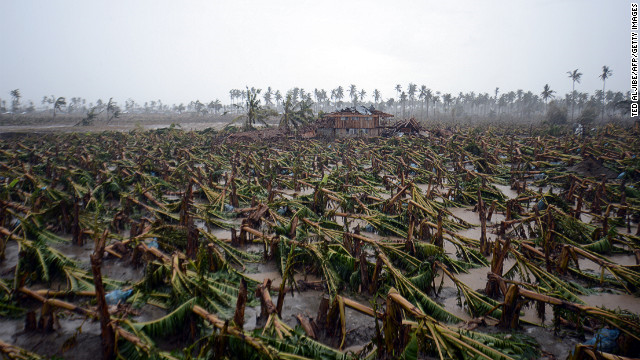Philippines typhoon deaths rise as president declares state of calamity
By Liz Neisloss and Jethro Mullen
8 December 2012 Montevista, Philippines (CNN) – Philippine President Benigno Aquino III has declared a state of national calamity as the death toll from Typhoon Bopha, the strongest tropical cyclone to hit the Philippines in decades, continues to climb. At least 459 people have died since the typhoon, known locally as “Pablo,” hit Tuesday, the Philippines’ emergency management agency said Saturday, while about the same number are reported injured. Another 532 people have been reported missing, the National Disaster Risk Reduction and Management Council said. […]
Among the worst hit areas was the poor, remote Compostela Valley region on the southern Philippine island of Mindanao, where thousands of flimsy houses have been ripped to shreds. Scores of people died, many them swept away in flash floods that roared down from the hills. The epicenter of the devastation appears to have been in New Bataan, a town about 20 kilometers (12 miles) southeast of Montevista and close to the steep mountains.
The flash floods hit it head-on Tuesday, washing away families huddled in their homes and soldiers stationed in a compound in the town. […]
Large parts of New Bataan and many of the people who lived there are now buried under mud, fallen trees and rubble, said Arnaldo Arcadio, an emergency response program manager for Catholic Relief Services, a humanitarian group. “The mood is really gloomy,” he said Thursday after visiting the town, where 90% to 95% of the houses are believed to have been destroyed or damaged. Residents who evaded death now lack food, shelter and, most of all, drinking water, since the nearest source is 5 kilometers away, according to Arcadio. “They are just trying to survive,” he said, noting that the knee-deep mud in many places made it difficult to get around, with several areas of the town completely inaccessible. Bopha raked across Mindanao and several other Philippine islands before moving off into the South China Sea. The powerful typhoon brought savage winds that uprooted entire banana plantations in low-lying areas, and relentless rain that unleashed torrents of rocks and mud down the mountainsides where shanty-dwelling miners dig for gold. Preemptive action was taken in northern Mindanao, expected to feel the full force of the typhoon, but in the end it was the less prepared communities of Compostela Valley and Davao Oriental, further south and east, that bore the brunt. Many people either didn’t hear warnings or didn’t heed them, expecting the typhoon to hit further north, as usually happens. The disaster has left about a quarter of a million homeless and affected more than 5 million people overall, the National Disaster Risk Reduction and Management Council said Friday.
Philippines typhoon deaths rise as president declares state of calamity

